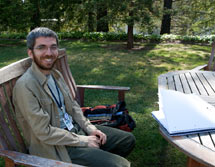
Handy Links
SLAC News Center
SLAC Today
- Subscribe
- Archives: Feb 2006-May 20, 2011
- Archives: May 23, 2011 and later
- Submit Feedback or Story Ideas
- About SLAC Today
SLAC News
Lab News
- Interactions
- Lightsources.org
- ILC NewsLine
- Int'l Science Grid This Week
- Fermilab Today
- Berkeley Lab News
- @brookhaven TODAY
- DOE Pulse
- CERN Courier
- DESY inForm
- US / LHC
SLAC Links
- Emergency
- Safety
- Policy Repository
- Site Entry Form

- Site Maps
- M & O Review
- Computing Status & Calendar
- SLAC Colloquium
- SLACspeak
- SLACspace
- SLAC Logo
- Café Menu
- Flea Market
- Web E-mail
- Marguerite Shuttle
- Discount Commuter Passes
-
Award Reporting Form
- SPIRES
- SciDoc
- Activity Groups
- Library
Stanford
Around the Bay
People: Marco Cammarata Tracks the Ultrafast
Marco Cammarata studies the superfast, from both a biological and a physical perspective. As a researcher at the European Synchrotron Radiation Facility in Grenoble, France, he studied the quick movements of the photosynthetic protein found in the bacteria strain Blastochloris viridis. Now at SLAC, he works as an instrument scientist with the Linac Coherent Light Source X-ray Pump Probe instrument, which uses the ultrafast X-ray pulses of the LCLS to study molecular movement, among other phenomena. The XPP team is currently busy fine-tuning and testing the equipment in preparation for commissioning, slated to begin in early June.
Photosynthetic proteins are much craftier than humans at harnessing sunlight and converting it into chemical energy. And because of this almost magical ability, scientists are eager to better understand the structure of these proteins and the sequence of events that leads to chemical energy production.
In France, Cammarata and his collaborators delivered pulses of visible photons to Blastochloris viridis protein crystals to trigger photoactivaction—a process that is very similar to steps in photosynthesis. Then they exposed the samples to X-rays to create an image. The first pulse of photons activates a chain of events wherein the protein converts sunlight into chemical energy. Taking an X-ray picture just milliseconds after this activation clues scientists in to how this reaction occurs. The X-rays scatter upon striking the protein, creating a pattern from which the protein structure can be recreated. In this instance, the researchers learned more about the protein structure and how it moves during the photosynthetic reaction. This work, led by R. Neutze from Göteborg University, was recently published in the journal Science.
Here at SLAC, Cammarata and his colleagues at XPP will have the chance to further photochemical research, working with a group of LCLS users―European and American scientists―on a subject similar to Cammarata's Science paper. The LCLS can emit the photon and X-ray pulses on a much shorter timescale than any existing synchrotron. In Cammarata's previous experiments, the shortest timescale available was 100 picoseconds. Now, at LCLS, it will be more like 20 femtoseconds—on the order of 5,000 times faster.
"The beauty is, you can study things right after they start happening," Cammarata said. That is, with the uber-fast pulses coming from the LCLS, its X-rays can capture the movement of atoms and electrons just after the reaction is triggered. Catching the movement of atoms and electrons earlier in the process will yield clearer images, because the movement of particles becomes increasingly blurred as they proceed through a chain of events.
"With the LCLS, it should be easier to understand what is happening," Cammarata said. "These systems are extremely fast. There's been no possibility of studying these reactions before now."
As instrument scientists with the XPP, Cammarata and his colleagues are getting ready for commissioning, which will start on June 7, and the arrival of user groups in October. In his new role at SLAC, Cammarata will spend more time fine-tuning the equipment and assisting user groups than conducting experiments himself, but he points out that he'll still have the chance to dabble in research science. He said he believes that in order to be a good instrument scientist, continuing with research is vital, as a way of maintaining curiosity and motivation.
"The beamline has a portion of time reserved for in-house research," Cammarata said. "That's one of the reasons why I came here."
—Julie Karceski
SLAC Today, May 19, 2010
